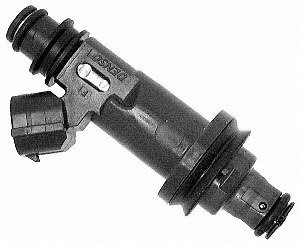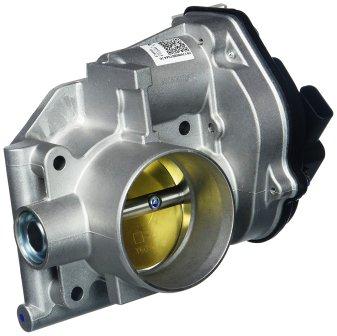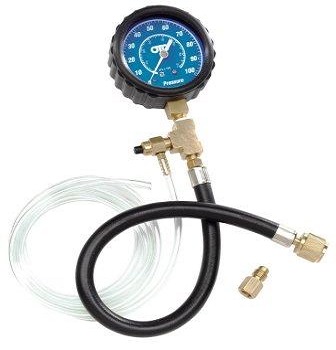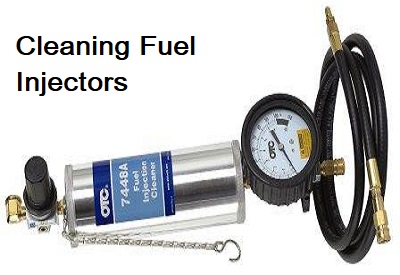
This guide to cleaning fuel injectors is meant to provide detailed information about servicing fuel injectors. All too often the auto repair shop recommends a fuel injection cleaning service without providing the details of why they recommend. As a professional mechanic I can tell you cleaning fuel injectors are often an exercise in futility.
In other words, if an injector is malfunctioning, cleaning it isn’t the same thing as repairing it or replacing it. Some shops might provide the argument that fuel is dirty and sediment collects in the fuel injectors and therefore needs regular servicing. The gas station filters the fuel several times from the ground tank to the pump nozzle. Then when it gets into your fuel tank, it’s filtered two more times before reaching the fuel injector.
To clarify that statement, there’s a filtering device before and after the electric fuel pump. The pre-filter is sometimes called a sock. This nylon mesh screen prevents particles from entering the fuel pump. After the fuel pump the factory installed a canister style filter that offers two-stage micro filtration of the gasoline. In other words, very little sediment reaches your fuel injectors. Although few and far between, there becomes instances where a cleaning might do some good. Here we’ll discuss whether cleaning fuel injectors remain a waste of time for you and your automobile.
Fuel Injection or Throttle Body Service

One of the most confusing things to consumers becomes the difference between a fuel injection service and throttle body service. Even some retail auto repair centers confuse the two terms when selling this maintenance service to consumers. Therefore, it’s vital to know the difference between the two separate operations.
A fuel injection service is cleaning of the fuel injectors. If the shop is performing this correctly, they disconnect the vehicle’s fuel tank from the engine and run a specialized cleaning solution directly through the fuel injectors. In other words, they connect a specialized machine to the fuel rail that directly feeds to fuel injectors while the engine is running.
One of the favorite things for an auto repair center to sell is a throttle body service. Although the shop may call this a fuel injection service, it actually has nothing to do with the fuel injectors themselves. In fact, this is an operation where they cleaned the throttle plates only. This is where the air enters the engine and this device can become dirty over time. With that said, most manufacturers don’t recommend a throttle body service, because the computer can compensate for a dirty throttle body.
Do I need a Fuel Injection Cleaning
In an effort to be fair to the retail auto repair center in many cases just recommend this service as a preventive maintenance operation. You can learn more about the maintenance items you can skip and why. Nevertheless, they sometimes make it clear that the operation is not intended to solve any problem or provide any boost in performance or fuel economy. However, when these things aren’t made clear, the shop must explain how the service benefits the automobile and why.
Automobile manufacturers developed and deployed different types of fuel injectors throughout the years. Some of these provide poor service or fail completely. However, running cleaning solution through these parts doesn’t help these poorly designed fuel injection. In fact, it’s actually possible the cleaning solution could make a failing fuel injector worse. Automotive technician’s own three separate tools to determine whether running a cleaner through the fuel injector carries the possibility of success.
Diagnosing Clogged Fuel Injectors

When car owners suffer from a fuel injection type problem the automobile displays a specific range of symptoms. These include a rough running engine, a lack of power or maybe a check engine light. Random misfire codes or injector driver codes set in the computer’s memory when you have a completely failed injector.
In an effort to properly diagnose the issue the mechanic should own three distinct fuel system tools. A fuel pressure gauge, an injector driver light and an injector balance tester. When an automobile is experiencing a fuel system problem the first thing to verify is the right amount of pressure in the rail up to the injector. A trained mechanic uses a fuel pressure gauge to accomplish this. Readings usually fall within 40 to 75 psi depending on the vehicle. Consult your professional PDF auto repair manual for exact details on your model.
Technicians call an injector driver test light a noid light. This low-voltage test light plugs into the fuel injector electrical connector. The light illuminates every time the injector gets fired by the computer. This verifies the proper operation of the electrical side of the equation. Finally, we have the injection balance tester. This device triggers the injector to open for a specific period of time. The technician then watches the pressure drop on the fuel rail. Each separate fuel injector should bleed off the same amount of pressure. We consider one that does not drop the pressure evenly either defective or clogged.
Cleaning Fuel Injectors Final Thoughts
The average fuel injection service carries a retail price point of around $100. This can vary depending on your geographical location and the type of car you drive. All too often I see shops that have identified a defective fuel injector and tell the consumers that a cleaning service is worth a try. This adds an extra $100 dollars to the auto repair estimate. Consider doing some research about repair trends for your specific year, make and model.
As an example, Search for fuel injector problems followed by the type of car you drive. Chances are, if you’re having problems in this automotive system so do others that drive the same vehicle. These people take to the Internet in massive numbers looking for solutions to their problem. Make sure you take advantage of this and learn from their successes and failures in an effort to repair the automobile efficiently.

